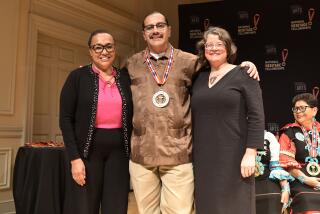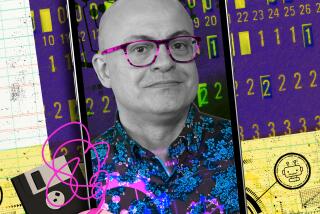At 80, Colombian artist Fernando Botero has no plans to retire
BOGOTA, Colombia — Honored here on his 80th birthday last week with a congressional medal and dinner with the president, Colombia’s most famous artist, Fernando Botero, says he’ll keep working until he keels over with “a paintbrush in my hand.”
But the politically attuned artist, whose themes have included mass murders, vicious drug capos and torture as well as his trademark “volumetric” nudes and whimsical reworkings of old masters, is skeptical that he will live to see the peace his countrymen so desperately want.
“Colombia is now living the best moment it has in 12 or 13 years. You can go out on the street at night and drive out to the country without being afraid of a kidnap,” Botero, a down-to-earth, blunt-spoken paisa, as natives of Medellin are known here, said in an interview in Bogota a few days before his birthday, April 19. “But there is still the problem of peace.”
Peace or no, Botero’s artwork hasn’t suffered in the marketplace: One of his paintings recently sold for $2.2 million, and a sculpture for $1.7 million.
Perhaps the best-known Botero collector is the eccentric industrialist-yachtsman William Koch, who shuttles nine monumental Botero sculptures, each weighing more than a ton, between his homes on Cape Cod, Mass., and in Palm Beach, Fla. In the 1990s, Koch brought them along to San Diego when he competed in the America’s Cup yacht race.
Botero, son of a mule driver, has made his living from art since he was 17, when he sold illustrations to his hometown newspaper, El Colombiano. Botero’s work now attracts highbrow museum curators and humble country people who hand him news clippings to autograph when he makes his once-yearly trip to his ranch outside Medellin.
“My popularity has to do with the divorce between modern art, where everything is obscure, and the viewer who often feels he needs a professor to tell them whether it’s good or not,” Botero said. “I believe a painting has to talk directly to the viewer, with composition, color and design, without a professor to explain it.”
The accessibility of Botero’s work stems from its “satire, humor, compassion and often political criticism,” said Mary-Anne Martin, whose New York art dealership specializes in Latin American art. The high volume of Botero’s output has made him an art world powerhouse, she said, but the critics are not universally sold.
“Some people say his fat figures are a gimmick,” Martin said. “Well, what about the attenuated figures of El Greco or Pontormo? Gimmicks?”
Botero’s political commentary was evident in his 2005 series of 40 paintings inspired, he says, by a Seymour Hersh expose in New Yorker magazine on torture and human rights abuses by U.S. troops atIraq’sAbu Ghraib prison. “I read it on a plane and went home and got to work. They took me 14 months to paint.”
They were shown at the UC Berkeley campus gallery because it was the only U.S. university that accepted his offer to exhibit them. He later donated most of the paintings to the university. Contrary to warnings from some of his friends, there were no political repercussions and his U.S. visa was not revoked.
“I had problems with President Bush’s policies, but not with the United States. There is freedom of expression there,” Botero said.
Is another politically charged cycle of works on the way? “Not now, but the day an idea arrives, I’ll get started,” he said.
Botero spends just one month a year in his homeland; the rest of the time he’s mostly in Monte Carlo and Tuscany. This year, he arrived home at a time of renewed hope for an end to Colombia’s long-running civil conflict, which has pitted drug-financed leftist guerrilla groups such as the FARC against a military that has grown in size and sophistication thanks to $7 billion in aid from the U.S.
Nothing would please him more than to see rumors of peace come true. It’s time for the guerrillas, who came close to “strangling” the country a decade ago, to recognize that they have lost the fight, the artist said.
He joked that perhaps President Juan Manuel Santos would give him the inside scoop on rumors of impending negotiations with rebels.
“The day the war ends will be marvelous for the country,” he said. “Once peace arrives, what follows the peace process won’t be any 15 minutes or 30 minutes of fame but a boom that will make Colombia a hemispheric power. This country has a lot to offer.”
Kraul is a special correspondent.
More to Read
Sign up for Essential California
The most important California stories and recommendations in your inbox every morning.
You may occasionally receive promotional content from the Los Angeles Times.










